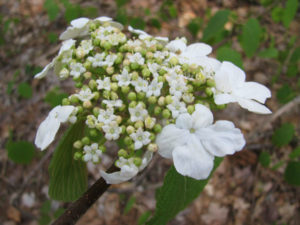(by Melissa Moore)
You’ve seen Hobblebush along hiking trails and forest walks. Maybe you’ve tripped over it. This native shrub takes its name from its unique growth habit. As the branches grow, they point downward and root where the tip meets the ground. On the hiking trail if left unchecked, the newly rooted tip will form an arch that is a like a wicket. Your foot may find it before you notice it with your eyes. This is why its common name is Hobblebush. The botanical name is Viburnum lantanoides.
Hobblebush goes by a few other names such as Witch Hobble and Moosebush. The Witch Hobble name derives from the Middle English word “wyche” which means pliable and flexible. These terms describe the branches of the Hobblebush.

After bloom time, fruit will appear. As the growing season progress, the fruits change from green, to pink, then red, and finally black. These fruits are a treat to songbirds and small mammals. Cedar Waxwings are attracted to Hobblebush berries as well as chipmunks. The branches are a browsing favorite of moose and deer. During the fall, leaves take on a burgundy red color. The variety of color patterns in its fall leaves is just another feature that has made the Hobblebush a favorite. Many outdoor enthusiasts sing praises and post photos for the Hobblebush on hiking blogs and nature apps.
Photos: Hobblebush in winter showing the distinctive buds and branching caused by deer and moose browse (top) by Becky Suomala; Flower cluster showing the larger, showy infertile flowers on the outer edge, by Diane De Luca.
